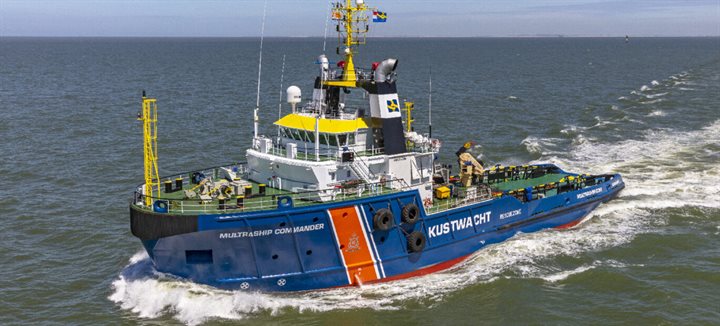ERTV
The Coast Guard uses several Emergency Response Towing Vessels (ERTVs): big, strong emergency towing vessels. These ERTVs help to prevent vessels in distress from colliding with wind turbines and other objects in a wind farm. Rijkswaterstaat is investigating how the ERTVs can best be deployed for this objective. This knowledge makes it possible for vessels in distress to be reached more quickly, reducing the chance of collisions.

There are several reasons why vessels may run into problems; these include storms and technical issues. An ERTV can keep a vessel in distress in one position or, weather permitting, tow it to a safer location. An ERTV is intended to remove any immediate danger to a vessel and/or the surrounding area. Once this has been resolved, a commercial tug boat can help the vessel in distress if necessary.
The sub-issues for this topic are:
- What are the optimum stand-by sites for ERTVs?
- In what sorts of situation should ERTVs be used?
- How can ERTVs be better used?
Research into optimum ERTV stand-by sites
The 'MOSWOZ Shipping Safety Risk Indicators' study (in Dutch) was published in 2022. This study focused on the optimum stand-by sites for ERTVs in the Dutch section of the North Sea. The weather, the busy shipping lanes and the location of wind farms all have an influence on the best stand-by sites.
Studies into ERTV training calendar and use
In 2024, Rijkswaterstaat will be devoting attention to a number of studies. One of those is the 'Training calendar' pilot. The aim of this study is to configure the training calendar in the best way possible. Training with ERTVs contributes to effective use. Another study addresses the most effective way of using the ERTVs. In addition to emergency towing they can also be used for search and rescue operations. For instance, a helicopter may deliver a MIRG team (Maritime Incident Response Group) to an ERTV to fight fires on board vessels.
Simulator study and ERTV
To put the ERTVs to their best use it is important to take human factors into account. A large-scale simulator study is being held in 2024, in which seafarers carry out drills in a shipping simulator that emulates stressful situations in the vicinity of wind farms on the North Sea. The simulator study gives an insight into how decisions are taken on the bridge of a vessel. How the decision-making process runs leading up to the first moment of contact with the Coast Guard is also studied. This knowledge helps ERTVs to reach vessels in distress more rapidly.